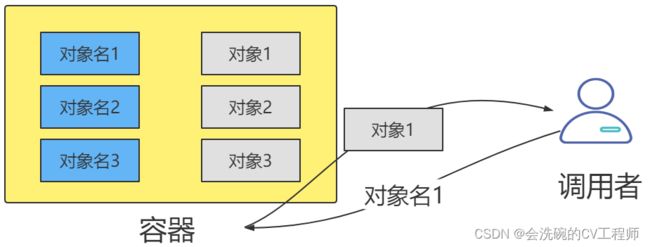目录
前言
Spring简介
Spring体系结构
一、IOC控制反转思想
二、IOC自定义对象容器
1. 创建实体类,Dao接口,实现类
2. 创建配置文件bean.properties
3. 创建容器管理类
4. 创建StudentService类
5. 测试方法
6. 测试结果
前言
Spring简介
Spring是一个开源框架,为简化企业级开发而生。它以IOC(控制反转)和AOP(面向切面)为思想内核,提供了控制层SpringMVC、数据层SpringData、服务层事务管理等众多技术,并可以整合众多第三方框架。Spring将很多复杂的代码变得优雅简洁,有效的降低代码的耦合度,极大的方便项目的后期维护、升级和扩展。
Spring官方网站:
Spring体系结构
Spring框架根据不同的功能被划分成了多个模块,这些模块可以满足一切企业级应用开发的需求,在开发过程中可以根据需求有选择性地使用所需要的模块。
Core Container:Spring核心模块,任何功能的使用都离不开该模块,是其他模块建立的基础。
Data Access/Integration:该模块提供了数据持久化的相应功能。
Web:该模块提供了web开发的相应功能。
AOP:提供了面向切面编程实现
Aspects:提供与AspectJ框架的集成,该框架是一个面向切面编程框架。
Instrumentation:提供了类工具的支持和类加载器的实现,可以在特定的应用服务器中使用。
Messaging:为Spring框架集成一些基础的报文传送应用
Test:提供与测试框架的集成
一、IOC控制反转思想
控制反转就是让框架创建对象
IOC(Inversion of Control) :程序将创建对象的权利交给框架。之前在开发过程中,对象实例的创建是由调用者管理的,代码如下:
public interface StudentDao {
// 根据id查询学生
Student findById(int id);
}
public class StudentDaoImpl implements StudentDao{
@Override
public Student findById(int id) {
// 模拟从数据库查找出学生
return new Student(1,"程序员","北京");
}
}
public class StudentService {
public Student findStudentById(int id){
// 此处就是调用者在创建对象
StudentDao studentDao = newStudentDaoImpl();
return studentDao.findById(1);
}
}这种写法有两个缺点:
浪费资源 :StudentService调用方法时即会创建一个对象,如果不断调用方法则会创建大量StudentDao对象。代码耦合度高 :假设随着开发,我们创建了StudentDao另一个更加完善的实现类StudentDaoImpl2,如果在StudentService中想使用StudentDaoImpl2,则必须修改源码。
而IOC思想是将创建对象的权利交给框架,框架会帮助我们创建对象,分配对象的使用,控制权由程序代码转移到了框架中,控制权发生了反转,这就是Spring的IOC思想。而IOC思想可以完美的解决以上两个问题。
二、IOC自定义对象容器
接下来我们通过一段代码模拟IOC思想。创建一个集合容器,先将对象创建出来放到容器中,需要使用对象时,只需要从容器中获取对象即可,而不需要重新创建,此时容器就是对象的管理者。
1. 创建实体类,Dao接口,实现类
Student实体类
package com.example.pojo;
public class Student {
private int id;
private String name;
private String address;
public Student(int id, String name, String address) {
this.id = id;
this.name = name;
this.address = address;
}
public Student(){}
public int getId() {
return id;
}
public void setId(int id) {
this.id = id;
}
public String getName() {
return name;
}
public void setName(String name) {
this.name = name;
}
public String getAddress() {
return address;
}
public void setAddress(String address) {
this.address = address;
}
@Override
public String toString() {
return "Student[ " +
"id=" + id +
", name='" + name + '\'' +
", address='" + address + '\'' +
" ]";
}
}
StudentDao接口
package com.example.dao;
import com.example.pojo.Student;
public interface StudentDao {
// 根据id查询学生
Student findById(int id);
}
StudentDao接口实现类1:StudentDaoImpl1
package com.example.dao;
import com.example.pojo.Student;
public class StudentDaoImpl1 implements StudentDao{
public StudentDaoImpl1() {
}
public StudentDaoImpl1(int a){};
@Override
public Student findById(int id){
return new Student(id,"程序员","北京");
}
}
StudentDao接口实现类1:StudentDaoImpl2
package com.example.dao;
import com.example.pojo.Student;
public class StudentDaoImpl2 implements StudentDao{
@Override
public Student findById(int id) {
// 模拟根据ID查询学生
System.out.println("新方法!!!");
return new Student(id,"程序员","上海");
}
}
2. 创建配置文件bean.properties
该文件中定义管理的对象
studentDao=com.example.dao.StudentDaoImpl23. 创建容器管理类
package com.example;
import java.io.InputStream;
import java.util.Enumeration;
import java.util.HashMap;
import java.util.Map;
import java.util.Properties;
public class Container {
static Map map = new HashMap<>();
static {
// 读取配置文件
InputStream is = Container.class.getClassLoader().getResourceAsStream("bean.properties");
Properties properties = new Properties();
try{
properties.load(is);
}catch (Exception e){
e.printStackTrace();
}
// 遍历配置文件的所有配置
Enumeration keys = properties.keys();
while(keys.hasMoreElements()){
String key = keys.nextElement().toString();
String value = properties.getProperty(key);
try{
Object o = Class.forName(value).newInstance();
map.put(key,o);
}catch (Exception e){
e.printStackTrace();
}
}
}
// 从容器中获取对象
public static Object getBean(String key){
return map.get(key);
}
}
4. 创建StudentService类
package com.example.service;
import com.example.Container;
import com.example.dao.StudentDao;
import com.example.domain.Student;
public class StudentService {
public Student findStudentById(int id){
// 从容器中获取对象
StudentDao studentDao = (StudentDao) Container.getBean("studentDao");
System.out.println(studentDao.hashCode());
return studentDao.findById(id);
}
}
5. 测试方法
package com.example.test;
import com.example.Container;
import com.example.service.StudentService;
public class Test {
public static void main(String[] args) {
StudentService studentService = new StudentService();
System.out.println(studentService.findStudentById(1));
System.out.println(studentService.findStudentById(1));
}
}
6. 测试结果
StudentService从容器中每次拿到的都是同一个StudentDao对象,节约了资源。
studentDao=com.itbaizhan.dao.StudentDaoImpl2即可,无需修改Java源码。
或者如果不想new
studentService = com.example.service.StudentService
你可能感兴趣的:(ssm框架,#,Spring,java,maven,spring,mybatis)
Spring Quick - 企业级Spring Boot快速启动框架深度解析
Jing_saveSlave
spring boot spring spring boot java
SpringQuick,顾名思义,是作者本人创建的一个基于SpringBoot+MyBatis-Plus+Sa-Token+Knife4j等框架结构搭建的一个企业级脚手架,方便企业及开发人员直接上手使用。并在项目中集成常用工具类,如MyBatis-Plus-Generator,Redisson等。还整合了整个项目代码四层架构规范(代码生成同时配置此规范)、统一响应体设计、业务异常、切面异常规范、切
Java 的 JDK 8,11,17,21 新特性 ,最新面试题
扫地僧009
互联网大厂面试题 java 开发语言
JDK8中lambda表达式的引入有什么意义?JDK8中引入的lambda表达式标志着Java对函数式编程范式的支持。这一新特性有以下几个重要意义:1、代码更简洁:使用lambda表达式可以用更少的代码实现相同的功能,尤其是在使用匿名内部类的地方。2、增强集合库的功能:通过引入StreamAPI,lambda表达式使得对集合进行序列化操作变得更加简单和高效。3、提高编程效率:lambda表达式使得
07 Java 工程师面试技巧篇
明明如月学长
Java 校招求职如何拿大厂 Offer java 开发语言 后端
一、背景Java工程师面试是否有一些技巧可循呢?答案是肯定的。本文结合自己的校招和社招经验,总结一些面试技巧,会结合一些具体案例帮助大家理解这些面试技巧,希望对大家有帮助,帮助大家少走弯路。二、核心技巧2.1会的问题要回答全面有深度面试的关键是:别人会的,你掌握的更全面;别人不太会的你会,你能回答地更有深度。2.1.1会的问题,回答更全面(广度)很多同学在面试过程中遇到会的问题就窃喜,一顿回答之后
Qt——Qt控件之输入窗口-QTextEdit文本编辑框控件的使用总结(例程:文本编辑输入)
Winter_world
QT开发实战 qt 开发语言 QTextEdit控件 Qt文本编辑控件的使用
【系列专栏】:博主结合工作实践输出的,解决实际问题的专栏,朋友们看过来!《项目案例分享》《极客DIY开源分享》《嵌入式通用开发实战》《C++语言开发基础总结》《从0到1学习嵌入式Linux开发》《QT开发实战》《Android开发实战》《实用硬件方案设计》《结构建模设计》《数据库开发总结》《JAVA入门基础》《JavaWeb开发实战》长期持续带来更多案例与技术文章分享;欢迎商业项目咨询,10年+软
java题库app有什么,Java面试题库
m0_74824091
面试 学习路线 阿里巴巴 java 面试 开发语言
Java面试题库是一个学习刷题类软件,主要针对Java从业者设计,整合了众多基础的题目资源,涵盖面试中可能会遇到的各种出题内容;软件使用功能非常简单,上面就设置了题库和搜索等中心,打开软件就能看到其中各种不同的题目划分栏目,马上就能从推荐栏目找到需要练习的题目并打开练习学习,里面每个题目都提供相应的详细解释和对应的知识点击内容,让用户能高效的掌握该问题考察的考点信息;这里的题库资源丰富,还按照多种
Spring Cloud + Nacos + K8S 零影响发布方案
淡黄的Cherry
微服务相关 kubernetes spring cloud 容器
问题描述在生产环境中使用springcloud框架,由于服务更新过程中,容器服务会被直接停止,部分请求仍被分发到终止的容器,导致服务出现500错误,这部分错误请求数据占用比较少,因为Pod滚动更新都是一对一。因为部分用户会产生服务器错误的情况,考虑使用优雅的终止方式,将错误请求降到最低,直至滚动更新不影响用户。这里结合nacos使用来分析。在K8s的滚动升级中,比如5个Pod服务在升级过程中,会先
JavaScript 简单类型与复杂类型-堆和栈
難釋懷
javascript 开发语言
深入理解JavaScript中的简单类型(基本数据类型)与复杂类型(引用数据类型)如何在内存中存储对于编写高效、无误的代码至关重要。本文将探讨这两种类型的差异,以及它们在内存中的存储机制——栈(Stack)和堆(Heap),并通过实例说明这些概念的实际应用。内存基础:栈与堆栈(Stack)栈是一种后进先出(LIFO,LastInFirstOut)的数据结构,通常用于存储函数调用信息和局部变量。由于
Java:实现导出报表到Excel表格(附带源码)
Katie。
java excel 开发语言
项目背景在许多企业应用中,生成报表并将其导出到Excel表格是一项常见需求。Java通过第三方库,如ApachePOI,可以实现将数据导出到Excel格式。ApachePOI提供了对MicrosoftExcel文件(.xls和.xlsx格式)的支持,可以让我们在Java程序中轻松生成Excel报表。本项目的目标是实现一个Java程序,生成一个简单的报表,并将其导出为Excel表格(.xlsx格式)
netty详细使用
酷爱码
编程学习 netty
Netty是一个基于Java的高性能网络应用框架,主要用于快速开发高性能的网络通信应用程序。以下是Netty的详细使用步骤:添加Netty依赖:在项目的pom.xml中添加Netty的依赖项,例如:io.nettynetty-all4.1.66.Final创建Netty服务器:编写一个Netty服务器应用程序,监听指定的端口,并处理网络请求。以下是一个简单的示例:publicclassNettyS
Android面试题-多线程(99题)
猎羽
Android 面试题 面试题 android
Android面试题之多线程,包括线程、Java同步问题、阻塞队列、线程池、AsyncTask、HandlerThread、IntentService等内容。本文是我一点点归纳总结的干货,但是难免有疏忽和遗漏,希望不吝赐教。转载请注明链接:https://blog.csdn.net/feather_wch/article/details/81207725有帮助的话请点个赞!万分感谢!Android
Java基础常见面试题及详细答案(总结40个)
java梅洛
经验分享 数据库 大数据 java postgresql
最近看到网上流传着各种面试经验及面试题,往往都是一大堆技术题目贴上去,但是没有答案。为此我业余时间整理了40道Java基础常见的面试题及详细答案,望各路大牛发现不对的地方不吝赐教,留言即可。八种基本数据类型的大小,以及他们的封装类引用数据类型Switch能否用string做参数equals与==的区别自动装箱,常量池Object有哪些公用方法Java的四种引用,强弱软虚,用到的场景Hashcode
java字符串热点面试题
WangYaolove1314
java java 面试
为什么Java中的String是不可变的?这种设计有什么好处?1.为什么String是不可变的?在Java中,String被设计为不可变类,这意味着一旦创建了一个String对象,它的内容(即char[]数组中的字符)就不能被修改。这种设计是通过以下方式实现的:String类的内部使用一个final的char[]数组来存储字符数据。final修饰符确保了数组引用不会被重新赋值。所有修改字符串的操作
Spring框架中的AOP是什么?如何使用AOP实现切面编程和拦截器功能?
WangYaolove1314
spring java
1、Spring框架中的AOP是什么?如何使用AOP实现切面编程和拦截器功能?在Spring框架中,AOP(Aspect-OrientedProgramming,面向切面编程)是一种用于处理程序中不同方面的技术,例如日志、安全性、事务管理等。通过AOP,我们可以将特定的代码片段(称为切面)应用到应用程序的不同方面,而无需修改这些代码的其他部分。在Spring中,AOP的实现基于Java的动态代理和
面试基础--线程生命周期、线程池(ThreadPoolExecutor 工作原理)
WeiLai1112
后端 java 面试 开发语言 后端 架构 分布式
深入解析线程生命周期与线程池(ThreadPoolExecutor)的工作原理:从源码到底层实现在现代高并发的互联网应用中,多线程编程是提升系统性能的重要手段之一。然而,线程的创建、销毁以及管理成本较高,直接使用线程可能会导致系统资源耗尽。为了解决这一问题,Java提供了线程池(ThreadPoolExecutor)机制,能够高效地管理线程的生命周期,提升系统性能。本文将深入探讨线程的生命周期、线
java开发工程师面试技巧
酷爱码
经验分享 java 面试 开发语言
Java开发工程师面试是一个常见的技术岗位面试,以下是一些面试技巧和建议:熟悉Java基础知识:在面试中,会经常被问到Java基础知识,包括面向对象编程、集合框架、异常处理、多线程等内容。要确保对这些知识点有扎实的掌握。练习编程题目:在面试中,通常会有编程题目要求,因此建议提前练习一些常见的编程题目,例如算法和数据结构题目。深入了解项目经历:准备好详细了解自己之前的项目经历,包括项目的背景、自己的
二叉树-二叉树的所有路径
Hasno.
深度优先 算法
代码随想录-刷题笔记257.二叉树的所有路径-力扣(LeetCode)内容:本题是一道递归+回溯的问题,其实递归和回溯是一个意思,但是这道题一定要明显的进行一次回溯。毕竟每一条路径都不太一样,收集完一次结果之后,需要把上一次探的节点给撤销.这一步就是很明显回溯回溯部分在回溯篇章再去详细写一篇笔记,因此本文只做介绍,至于路径问题,真可谓是回溯的常客了.哦,对每次都想吐槽一下Java的神奇的字符串,必
【微服务】SpringBoot 自定义消息转换器使用详解
小码农叔叔
springboot 入门到精通 springboot消息转换器 spring消息转换器详解 消息转换器使用详解 springmvc消息转换器 spring自定义消息转换器 自定义消息转换器
目录一、前言二、SpringBoot内容协商介绍2.1什么是内容协商2.2内容协商机制深入理解2.2.1内容协商产生的场景2.3内容协商实现的常用方式2.3.1前置准备2.3.2通过HTTP请求头2.3.2.1操作示例2.3.3通过请求参数三、SpringBoot消息转换器介绍3.1HttpMessageConvertor介绍3.1.1常用的HttpMessageConvertor3.2如何确定使
【设计模式】完整版(Java)
浪子西科
设计模式 设计模式 java 单例模式
设计模式文章目录设计模式一、引言二、创建型设计模式2.1单例模式2.2工厂模式2.3抽象工厂模式2.4建造者模式2.5原型模式三、结构型设计模式3.1代理模式3.2适配器模式3.3桥接模式3.4装饰器模式3.5外观模式3.6组合模式3.7享元模式四、行为型设计模式4.1策略模式4.2模板方法模式4.3观察者模式4.4迭代器模式4.5责任链模式4.6命令模式4.7备忘录模式4.8状态模式4.9访问者
Golang架构直通车——理解协程和Go调度器
No_Game_No_Life_
Golang架构直通车
文章目录进程、线程与协程Go协程:GoroutinesGo协程调度器Go调度器的设计策略为什么Java坚持多线程而不选择协程?协程和Channel的使用建议进程、线程与协程线程或者进程切换会带来大量的系统开销和上下文切换成本,导致严重的系统开销。在之前的文章中,我们提到过切换进程的开销:切换虚拟地址空间(切换页表、页目录以指向新的地址空间)切换内核栈切换硬件上下文虽然线程切换不需要执行第一步(因为
[原创]手把手教学之前端0基础到就业---day15堆和栈 + 作业part3(Javascript)
*星之卡比*
javascript 开发语言 ecmascript
7.数据存储—栈(stack)和堆(heap)前面我讲过,数据类型分为基本数据类型(简单数据类型)和复杂数据类型(引用数据类型)基本数据类型和复杂数据类型最大的区别就是存储上的区别下图里的灰色区域可以看做我们的内存空间,黄色是栈空间,橘黄色是堆空间简单数据类型存储在栈空间里,比如变量名函数名,复杂数据类型存储在堆空间里栈内存:按序排列,先来的在栈底,后来的在栈顶,就像是堆叠盘子一样的在堆内存中,数
前端面试题---vue和react的区别
*星之卡比*
前端 vue.js react.js
文章目录框架vs库:学习曲线:模板vsJSX:数据绑定:状态管理:性能:社区支持:框架vs库:Vue是一个完整的框架,提供了从模板到状态管理的全套解决方案;React是一个UI库,主要聚焦于构建用户界面,其他功能依赖第三方库。学习曲线:Vue的语法更简洁,易于上手,适合初学者;React使用JSX,结合了JavaScript和HTML,学习曲线较陡。模板vsJSX:Vue使用类似HTML的模板语法
pinpoint安装及介绍
jack-life
pinpoint pinpoint
Pinpoint翻译自Pinpoint的github首页内容Pinpoint是一个开源的APM(ApplicationPerformanceManagement/应用性能管理)工具,用于基于Java的大规模分布式系统。仿照GoogleDapper,Pinpoint通过跟踪分布式应用之间的调用来提供解决方案,以帮助分析系统的总体结构和内部模块之间如何相互联系.注:对于各个模块之间的通讯英文原文中用的
【YashanDB 知识库】JDBC 驱动的 date 类型字段结果集调用 getString 方法只返回日期,不返回时分秒
数据库date
问题现象JDBC驱动查询date类型字段,对ResultSet直接调用getString方法,驱动返回的字符串只有日期,没有时分秒。如上Java代码片断只返回YYYY-MM-DD类型的字符串,没有带时分秒问题的风险及影响返回的字符串只有日期,没有时分秒,影响业务逻辑。问题影响的版本所有的YashanDB驱动。问题发生原因YashanDB驱动内部实现问题。解决方法及规避方式使用rs.getTimes
星河飞雪网络安全学习笔记-安全见闻1-3
芝士布偶
网络安全
安全见闻-了解安全知识编程语言日常编程语言C语言:一种通用的、面向过程的编程语言,广泛运用于系统软件呵呵嵌入式开发C++:面向对象的编程语言,常用于游戏开发、高性能计算等领域Java:一种广泛使用的面向对象编程语言、具有跨平台性、应用于企业级应用开发等Python(萌新推荐):简洁易学,拥有丰富的库,适用于数据分析、人工智能、web开发等Javascript:主要用于网页前端开发,也可用于服务器端
JavaScript 番茄工作法倒计时器:轻松实现时间管理,新手友好教程前端倒计时设计案例:用 JavaScript 实现番茄工作法,代码全解析从零开始构建番茄工作法倒计时器:JavaScript
南北极之间
前端进阶练手实战 javascript 前端 开发语言 1024程序员节 番茄工作法 倒计时
效果图:博客教程:用JavaScript构建番茄工作法倒计时器目录项目介绍工具与环境准备项目结构HTML构建页面结构CSS美化倒计时页面JavaScript实现倒计时与番茄工作法功能总结1.项目介绍在本教程中,我们将使用HTML、CSS和JavaScript创建一个带有番茄工作法的倒计时器。番茄工作法是一种有效的时间管理方法,将工作时间分为25分钟的工作时间和5分钟的休息时间循环。你将学习如何:使
Vue01
memorycx
vue.js javascript ecmascript
vuevue基础vue-clivue-routervuexelement-uivue3vue基础vue是什么一套用于构建用户界面的渐进式JavaScript框架采用组件化模式,提高diamagnetic复用率,让代码更好维护声明式编码,让编码人员无需直接操作DOM,提高开发效率去vue官网下载开发版本,然后在html文件中引入//这是在头部引入细节:root容器里的代码依然符合html规范,只不过
Java 中 Math.pow 的用法
Yuan_o_
JavaSE初阶 java 开发语言
常见用法pow是静态方法,要用类名Math来访问该方法,如下:Math.pow(底数a,指数b)表示a的b次方,返回类型为double应用:用Math.pow()实现数组的交错求和publicstaticvoidmain(String[]args){intn=0;inta=0;int[]b={1,2,3,4,5,6,7,8,9};for(inti=0;i
Java中的泛型是什么?它有什么作用?
python资深爱好者
java java
Java中的泛型是什么?它有什么作用?在Java中,泛型(Generics)是一个强大的工具,它允许你在定义类、接口和方法时使用类型参数(typeparameters)。这些类型参数在实例化时会被具体的类型所替换,从而实现了代码的重用和类型安全。以下是关于Java中泛型的一些详细解释:泛型的基本概念类型参数:在类、接口或方法声明中使用的特殊类型变量,用于指定类或方法所操作的对象类型。类型参数以大写
HarmonyOS学习第2天: 解锁语言与框架的无限可能
老三不说话、
HarmonyOS开发 harmonyos 学习 华为
HarmonyOS开发语言大盘点HarmonyOS为开发者提供了丰富的开发语言选择,每种语言都有其独特的优势和适用场景,能够满足不同类型应用开发的需求。Java:作为一种广泛使用且成熟的编程语言,Java在HarmonyOS开发中占据重要地位。它拥有卓越的跨平台能力,一次编写,到处运行,这使得开发者能够高效地开发出适用于多种设备的应用。其丰富的API库涵盖了网络、I/O、图形用户界面等多个方面,为
高效Java对象池:Commons-Pool2入门与进阶
中國移动丶移不动
java 开发语言 spring maven 后端
高效Java对象池:Commons-Pool2入门与进阶1.什么是池化技术以及池化技术的核心思想池化技术(Pooling)是一种通过预先创建并管理可复用资源来提升系统性能和资源利用率的设计思想。其核心是避免重复创建和销毁资源的开销,通过共享和复用资源来减少系统压力。池化技术的核心思想资源复用:重复利用已分配的资源(对象、线程、连接等),避免频繁创建和销毁。预先分配:在系统初始化时或按需提前创建一批
java杨辉三角
3213213333332132
java基础
package com.algorithm;
/**
* @Description 杨辉三角
* @author FuJianyong
* 2015-1-22上午10:10:59
*/
public class YangHui {
public static void main(String[] args) {
//初始化二维数组长度
int[][] y
《大话重构》之大布局的辛酸历史
白糖_
重构
《大话重构》中提到“大布局你伤不起”,如果企图重构一个陈旧的大型系统是有非常大的风险,重构不是想象中那么简单。我目前所在公司正好对产品做了一次“大布局重构”,下面我就分享这个“大布局”项目经验给大家。
背景
公司专注于企业级管理产品软件,企业有大中小之分,在2000年初公司用JSP/Servlet开发了一套针对中
电驴链接在线视频播放源码
dubinwei
源码 电驴 播放器 视频 ed2k
本项目是个搜索电驴(ed2k)链接的应用,借助于磁力视频播放器(官网:
http://loveandroid.duapp.com/ 开放平台),可以实现在线播放视频,也可以用迅雷或者其他下载工具下载。
项目源码:
http://git.oschina.net/svo/Emule,动态更新。也可从附件中下载。
项目源码依赖于两个库项目,库项目一链接:
http://git.oschina.
Javascript中函数的toString()方法
周凡杨
JavaScript js toString function object
简述
The toString() method returns a string representing the source code of the function.
简译之,Javascript的toString()方法返回一个代表函数源代码的字符串。
句法
function.
struts处理自定义异常
g21121
struts
很多时候我们会用到自定义异常来表示特定的错误情况,自定义异常比较简单,只要分清是运行时异常还是非运行时异常即可,运行时异常不需要捕获,继承自RuntimeException,是由容器自己抛出,例如空指针异常。
非运行时异常继承自Exception,在抛出后需要捕获,例如文件未找到异常。
此处我们用的是非运行时异常,首先定义一个异常LoginException:
/**
* 类描述:登录相
Linux中find常见用法示例
510888780
linux
Linux中find常见用法示例
·find path -option [ -print ] [ -exec -ok command ] {} \;
find命令的参数;
SpringMVC的各种参数绑定方式
Harry642
springMVC 绑定 表单
1. 基本数据类型(以int为例,其他类似):
Controller代码:
@RequestMapping("saysth.do")
public void test(int count) {
}
表单代码:
<form action="saysth.do" method="post&q
Java 获取Oracle ROWID
aijuans
java oracle
A ROWID is an identification tag unique for each row of an Oracle Database table. The ROWID can be thought of as a virtual column, containing the ID for each row.
The oracle.sql.ROWID class i
java获取方法的参数名
antlove
java jdk parameter method reflect
reflect.ClassInformationUtil.java
package reflect;
import javassist.ClassPool;
import javassist.CtClass;
import javassist.CtMethod;
import javassist.Modifier;
import javassist.bytecode.CodeAtt
JAVA正则表达式匹配 查找 替换 提取操作
百合不是茶
java 正则表达式 替换 提取 查找
正则表达式的查找;主要是用到String类中的split();
String str;
str.split();方法中传入按照什么规则截取,返回一个String数组
常见的截取规则:
str.split("\\.")按照.来截取
str.
Java中equals()与hashCode()方法详解
bijian1013
java set equals() hashCode()
一.equals()方法详解
equals()方法在object类中定义如下:
public boolean equals(Object obj) {
return (this == obj);
}
很明显是对两个对象的地址值进行的比较(即比较引用是否相同)。但是我们知道,String 、Math、I
精通Oracle10编程SQL(4)使用SQL语句
bijian1013
oracle 数据库 plsql
--工资级别表
create table SALGRADE
(
GRADE NUMBER(10),
LOSAL NUMBER(10,2),
HISAL NUMBER(10,2)
)
insert into SALGRADE values(1,0,100);
insert into SALGRADE values(2,100,200);
inser
【Nginx二】Nginx作为静态文件HTTP服务器
bit1129
HTTP服务器
Nginx作为静态文件HTTP服务器
在本地系统中创建/data/www目录,存放html文件(包括index.html)
创建/data/images目录,存放imags图片
在主配置文件中添加http指令
http {
server {
listen 80;
server_name
kafka获得最新partition offset
blackproof
kafka partition offset 最新
kafka获得partition下标,需要用到kafka的simpleconsumer
import java.util.ArrayList;
import java.util.Collections;
import java.util.Date;
import java.util.HashMap;
import java.util.List;
import java.
centos 7安装docker两种方式
ronin47
第一种是采用yum 方式
yum install -y docker
java-60-在O(1)时间删除链表结点
bylijinnan
java
public class DeleteNode_O1_Time {
/**
* Q 60 在O(1)时间删除链表结点
* 给定链表的头指针和一个结点指针(!!),在O(1)时间删除该结点
*
* Assume the list is:
* head->...->nodeToDelete->mNode->nNode->..
nginx利用proxy_cache来缓存文件
cfyme
cache
user zhangy users;
worker_processes 10;
error_log /var/vlogs/nginx_error.log crit;
pid /var/vlogs/nginx.pid;
#Specifies the value for ma
[JWFD开源工作流]JWFD嵌入式语法分析器负号的使用问题
comsci
嵌入式
假如我们需要用JWFD的语法分析模块定义一个带负号的方程式,直接在方程式之前添加负号是不正确的,而必须这样做:
string str01 = "a=3.14;b=2.71;c=0;c-((a*a)+(b*b))"
定义一个0整数c,然后用这个整数c去
如何集成支付宝官方文档
dai_lm
android
官方文档下载地址
https://b.alipay.com/order/productDetail.htm?productId=2012120700377310&tabId=4#ps-tabinfo-hash
集成的必要条件
1. 需要有自己的Server接收支付宝的消息
2. 需要先制作app,然后提交支付宝审核,通过后才能集成
调试的时候估计会真的扣款,请注意
应该在什么时候使用Hadoop
datamachine
hadoop
原帖地址:http://blog.chinaunix.net/uid-301743-id-3925358.html
存档,某些观点与我不谋而合,过度技术化不可取,且hadoop并非万能。
--------------------------------------------万能的分割线--------------------------------
有人问我,“你在大数据和Hado
在GridView中对于有外键的字段使用关联模型进行搜索和排序
dcj3sjt126com
yii
在GridView中使用关联模型进行搜索和排序
首先我们有两个模型它们直接有关联:
class Author extends CActiveRecord {
...
}
class Post extends CActiveRecord {
...
function relations() {
return array(
'
使用NSString 的格式化大全
dcj3sjt126com
Objective-C
格式定义The format specifiers supported by the NSString formatting methods and CFString formatting functions follow the IEEE printf specification; the specifiers are summarized in Table 1. Note that you c
使用activeX插件对象object滚动有重影
蕃薯耀
activeX插件 滚动有重影
使用activeX插件对象object滚动有重影 <object style="width:0;" id="abc" classid="CLSID:D3E3970F-2927-9680-BBB4-5D0889909DF6" codebase="activex/OAX339.CAB#
SpringMVC4零配置
hanqunfeng
springmvc4
基于Servlet3.0规范和SpringMVC4注解式配置方式,实现零xml配置,弄了个小demo,供交流讨论。
项目说明如下:
1.db.sql是项目中用到的表,数据库使用的是oracle11g
2.该项目使用mvn进行管理,私服为自搭建nexus,项目只用到一个第三方 jar,就是oracle的驱动;
3.默认项目为零配置启动,如果需要更改启动方式,请
《开源框架那点事儿16》:缓存相关代码的演变
j2eetop
开源框架
问题引入
上次我参与某个大型项目的优化工作,由于系统要求有比较高的TPS,因此就免不了要使用缓冲。
该项目中用的缓冲比较多,有MemCache,有Redis,有的还需要提供二级缓冲,也就是说应用服务器这层也可以设置一些缓冲。
当然去看相关实现代代码的时候,大致是下面的样子。
[java]
view plain
copy
print
?
public vo
AngularJS浅析
kvhur
JavaScript
概念
AngularJS is a structural framework for dynamic web apps.
了解更多详情请见原文链接:http://www.gbtags.com/gb/share/5726.htm
Directive
扩展html,给html添加声明语句,以便实现自己的需求。对于页面中html元素以ng为前缀的属性名称,ng是angular的命名空间
架构师之jdk的bug排查(一)---------------split的点号陷阱
nannan408
split
1.前言.
jdk1.6的lang包的split方法是有bug的,它不能有效识别A.b.c这种类型,导致截取长度始终是0.而对于其他字符,则无此问题.不知道官方有没有修复这个bug.
2.代码
String[] paths = "object.object2.prop11".split("'");
System.ou
如何对10亿数据量级的mongoDB作高效的全表扫描
quentinXXZ
mongodb
本文链接:
http://quentinXXZ.iteye.com/blog/2149440
一、正常情况下,不应该有这种需求
首先,大家应该有个概念,标题中的这个问题,在大多情况下是一个伪命题,不应该被提出来。要知道,对于一般较大数据量的数据库,全表查询,这种操作一般情况下是不应该出现的,在做正常查询的时候,如果是范围查询,你至少应该要加上limit。
说一下,
C语言算法之水仙花数
qiufeihu
c 算法
/**
* 水仙花数
*/
#include <stdio.h>
#define N 10
int main()
{
int x,y,z;
for(x=1;x<=N;x++)
for(y=0;y<=N;y++)
for(z=0;z<=N;z++)
if(x*100+y*10+z == x*x*x
JSP指令
wyzuomumu
jsp
jsp指令的一般语法格式: <%@ 指令名 属性 =”值 ” %>
常用的三种指令: page,include,taglib
page指令语法形式: <%@ page 属性 1=”值 1” 属性 2=”值 2”%>
include指令语法形式: <%@include file=”relative url”%> (jsp可以通过 include

